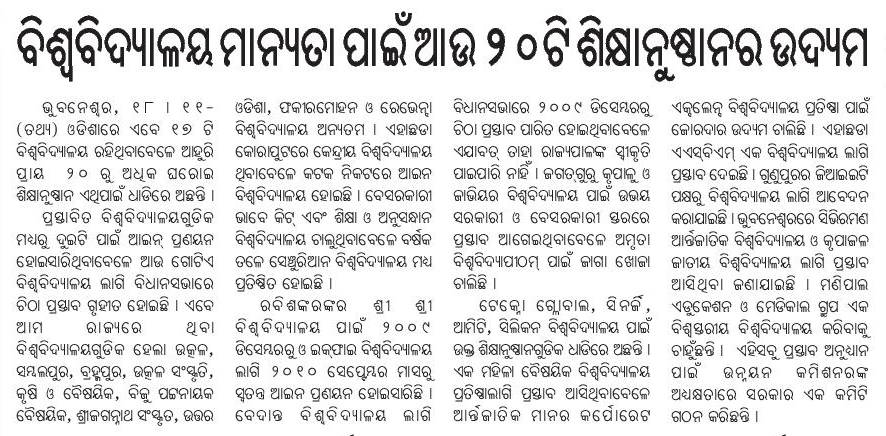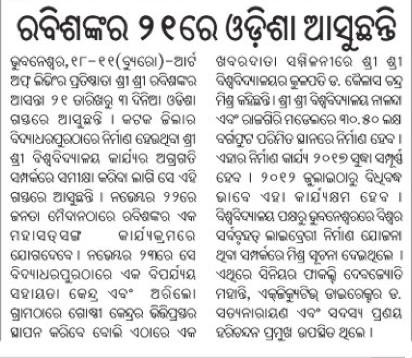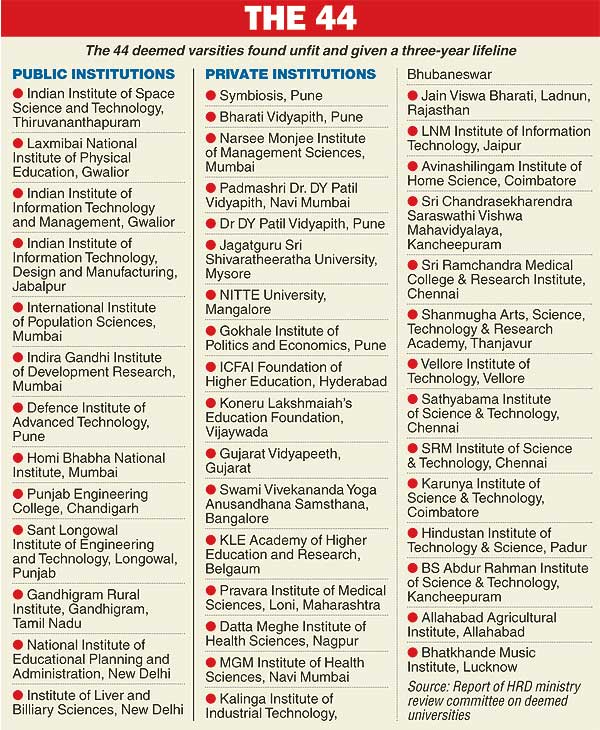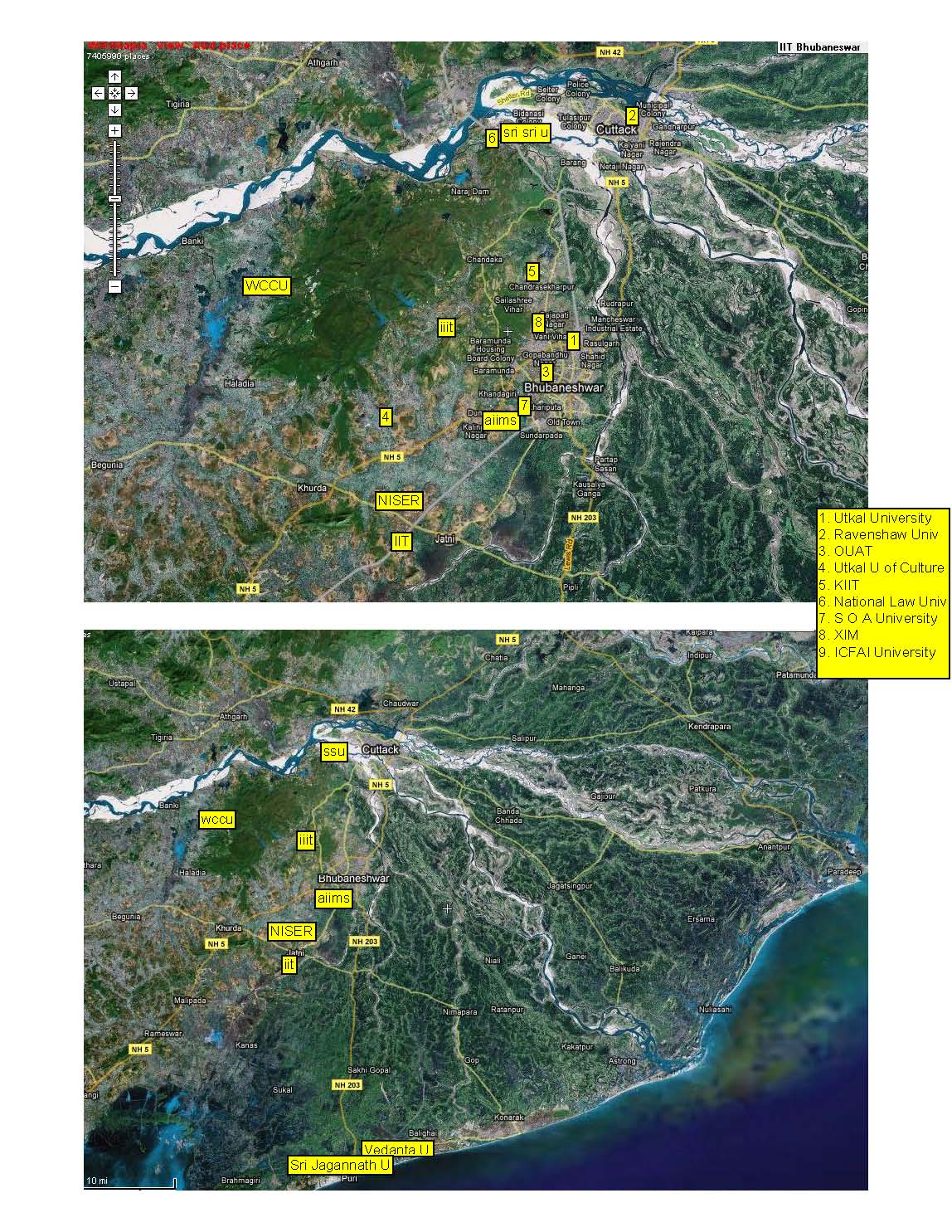Following is from Section 2 of the report by the 2009 committee which reviewed the then deemed universities and divided them to three categories; the second category (which included KIIT University Bhubaneswar) of universities were found somewhat deficient and given time to correct the deficiency and the third category (which included SOA University Bhubaneswar) were found deficient and it was recommended that the deemed tag may be taken away from them.
The committee consisted of Prof. P. N. Tandon, Prof. Goverdhan Mehta, Prof. M. Anandakrishnan, Prof. Mrinal Miri and Shri Sunil Kumar (Convenor).
Universities are institutions that are meant to sustain human practices and activities of a very special kind. They are, of course, concerned centrally with higher education and research, but their concern in these fields is very different from that of other institutions of higher learning and research which are devoted to imparting knowledge and skills that are essential to competent and creative pursuit of what might be called ‘technical professions’. Examples of such professions are: different branches of engineering, various aspects of medicine and surgery, and, in our times – because of the rise of corporations and bureaucratic governance -management and control of humans. It may be suggested, without much fear of contradiction, that the primary value of the kind of knowledge and skills imparted by such institutions resides in their utility – utility in creating an infrastructure for the physical wellbeing of the general public, utility in sustaining good health of individuals and the community, utility in enhancing the profit margins of corporations, and of course utility in terms of their own marketability. However, the very best of such institutions have shown the capacity to transcend utility, and this often has the effect of transforming the very quality of education they impart.
While universities are not entirely free from utility-driven higher education and learning, their core aim – if one may be allowed to say so – is very different. Universities are meant to be places -which facilitate and promote critical intellectual engagement with: (a) different traditions of thought and its great variety of expression, (b) modes of understanding the human condition and predicament, (c) the incredibly diverse inanimate and non-human living world. Such engagement obviously has many utilitarian and extrinsic values; but it is its intrinsic value that marks it off as a very special sort of human practice. It requires the development of a form of attention that focuses -beyond the interests of the self and its preoccupations with itself – on the other whether the other is a tradition of thought, or a particular human collectivity and its specific way of being human, or the physical world and its amazing intricacies, or the magieal variety of non-human life.
Such attention is valuable in itself not only because it entails the exercise of virtues such as honesty, courage and fairness, but, more importantly because these virtues must find a unity within the overarching virtue of care (some might even say, love). Care such as this requires the presence of the person – the whole ‘person – to the other, to the object of care. To be wholly present to the other in this way, is for the person to become more as a person. It enhances the human person as a person. The intrinsic value of university education lies ultimately in its inherent capacity to induce such enhancement of the person in us.
This is the truth of the commonly held belief that a truly educated person is larger as a person than an uneducated person. It is of course also true that a person may have gone through the process of education, including university education, and remained uneducated. Education has failed to make the difference in the latter instance which it is meant to have made. Some of the natural outcomes of such caring and critical attention and engagement are: traditions of thought and research are carried forward, creativity finds a central place, new modes of understanding and explanation emerge, just as new objects of such attention begin to loom on the horizon. These indeed are the intrinsic rewards of the practices sustained by a University. Think of the humanities, (which, as a result of the practicalities of the division of academic labour are split into "disciplines" such as literature, the arts, philosophy, history etc.); the human sciences (economics, psychology, anthropology, sociology and so on); the physical sciences including mathematics, the life sciences and exciting new areas of enquiry in them – think of them and the role of the Universities in taking them forward, in devising new modes of enquiry and uncovering fresh objects of study and thought.
It is important at this point to remind ourselves of what the Radhakrishnan Commission of Education 1948 had to say on the question of setting up of new universities – "….There are certain fundamental characteristics which should be inherent in any institution which is to call itself a university …It should be a place for providing a student with opportunity for all round well proportioned education for effective living and for citizenship, in addition to preparation for a calling. It may occur that a university shall develop special strength in some particular field, as in engineering or industrial development or in teacher-training or inforestry or fisheries. In fact, since no institution can be excellent in everything, it is desirable that areas of special strength be developed at least in all but perhaps the largest of our universities. However, these areas of special strength should be in addition to facilities for all round higher educqtion, and should not be a substitute for such facilities. Unless an institution aims at providing such all round training it should continue as a technical institute and should not aspire to be a university… Institutions doing perfunctory or mediocre work should not be dignified by university status."
Thus, what is crucial is that universities must not, in their various pursuits, lose sight of this essential concept of a university. There is, sadly, much truth in the general belief that many of our universities have willy-nilly lost sight of this idea. This has resulted in a certain debasement of the very concept of a university allowing institutions with little claim to the status of a university to aspire for such status.
November 27th, 2010
Update: As one may notice one of the existing colleges that is missing from the list below is:
- Purushottam Institute of Technology, Rourkela.
It is missing because the Industries department of Orissa has barred it from admitting students from Orissa JEE in 2009-2010. Some details are reported at http://dailypioneer.com/191657/Industry-dept-bars-Purushottam-Institute.html. It was allowed to fill up seats based on AIEEE though.
The list below is based on the availability of seats pages of http://jeeorissa.com/availability_of_seats.asp.
- Ajay Binay Institute of Technology Cuttack (ABT) Pvt.
- Apex Institute of Technology & Management, Pahal Bhubaneshwar (APT) Pvt.
- ARYAN INSTITUTE OF ENGINEERING & TECHNOLOGY PANCHAGAON, KHURDA Bhubaneswar (AIE) Pvt.
- Balasore College of Engineering & Technology Balasore (BCE) Pvt.
- Bhadrak Institute of Engineering & Technology Barapada, Bhadrak (BIT) Pvt.
- Bhubaneswar Engineering College Khurda (BEC) Pvt.
- Bhubaneswar Institute of Technology JANLA, KHURDA (BIB) Pvt.
- Black Diamond College of Engineering & Technology Jharsuguda (BDC) Pvt.
- BRM International Institute of Technology Bhubaneswar (BII) Pvt.
- C. V. Raman College of Engineering Bhubaneswar (CVR) Pvt.
- Central Institute of Plastics Engineering And Technology Bhubaneswar (CPT) Govt.
- Centurian Institute of Technology Khurda (CIK) Pvt.
- College of Engineering & Technology Bhubaneswar (CET) Govt.
- College of Engineering Bhubaneswar Bhubaneshwar (CEB) Pvt.
- Dhaneswar Rath Institute of Engineering and Management Studies Tangi, Cuttack (DRM) Pvt.
- Eastern Academy of Science & Technology Phulnakhara, Khurda (EAS) Pvt.
- EINSTEIN ACADEMY OF TECHNOLOGY & MANAGEMENT BANIATANGI, KHURDA (EAT) Pvt.
- EKLAVYA COLLEGE OF TECHNOLOGY & SCIENCE Jatni, Bhubaneswar (ECT) Pvt.
- GANDHI ACADEMY OF TECHNOLOGY & ENGINEERING GOLONTHARA, BERHAMPUR (GAT) Pvt.
- Gandhi Engineering College Bhubaneswar (GEC) Pvt.
- GANDHI INSTITUTE FOR EDUCATION & TECHNOLOGY BANIATANGI,KHURDA (GIE) Pvt.
- Gandhi Institute for Technology Bhubaneswar (GIF) Pvt.
- Gandhi Institute of Engineering & Technology Gunupur (GIT) Pvt.
- Gandhi Institute of Industrial Technology Berhampur (GII) Pvt.
- Gandhi Institute of Science and Technology Rayagada (GIR) Pvt.
- Gandhi Institute of Technological Advancement Badaraghunathpur, Bhubaneswar (GIB) Pvt.
- Gandhi Institute of Technology & Management Khurda (GIK) Pvt.
- Ghanashyama Hemalata Institute of Technology & Management Chhaitana Puri (GHT) Pvt.
- Gopal Krushna College of Engineering & Technology Jeypore (GCE) Pvt.
- Government College of Engineering Kalahandi Bhawanipatna, Kalahandi (GCK) Govt.
- GURUKUL COLLEGE OF ENGINEERING(FOR WOMEN) JAMUJHARI, BHUBANESWAR (GCW) Pvt.
- Gurukul Institute of Technology,Janla Bhubaneswar (GKT) Pvt.
- HITECH COLLEGE OF ENGINEERING BHUBANESWAR (HCE) Pvt.
- Hi-Tech Institute of Technology Khurda (HIT) Pvt.
- Indic Institute of Design & Research Khurda (IID) Pvt.
- Indira Gandhi Institute of Technology Sarang (IGT) Govt.
- INDOTECH COLLEGE OF ENGINEERING MALLIPADA, KHURDA (ICE) Pvt.
- Indus College of Engg. Bhubaneswar (IDU) Pvt.
- Institute of Advanced Computer & Research Rayagada (IAC) Pvt.
- International Institute of Information Technology(Self Sustaining) Gothapatana, Bhubaneswar (III) Govt.
- Jagannath Institute of Engineering & Technology Cuttack (JIC) Pvt.
- Jagannath Institute of Technology & Management Paralakhemundi (JIP) Pvt.
- Kalam Institute of Technology, Berhampur Berhampur (KIB) Pvt.
- KMBB COLLEGE OF ENGINEERING & TECHNOLOGY DALEIPUT, KHURDA (KCE) Pvt.
- Konark Institute of Science & Technology Jatni,Bhubaneswar (KIS) Pvt.
- Koustav Institute of Technology Bhubaneswar (KIT) Pvt.
- Koustuva Institute of Self Domain(for Women) Bhubaneswar (KID) Pvt.
- Krupajala Engineering College Pubasasan, Bhubaneswar (KEC) Pvt.
- Maharaja Institute of Technology,Bhubaneswar Bhubaneswar (MIK) Pvt.
- Mahavir Institute of Engineering and Technology Paniora, Bhubaneswar (MIB) Pvt.
- Majhighariani Institute of Technology and Science Rayagada (MIT) Pvt.
- Modern Engineering & Management Studies Balasore (MEM) Pvt.
- Modern Institute of Technology & Management Khurda (MIM) Pvt.
- Nalanda Institute of Technology Bhubaneswar (NIT) Pvt.
- National Institute of Science and Technology Palur Hills, Berhampur (NST) Pvt.
- NM Institute of Engineering & Technology Sijua, Bhubaneswar (NMI) Pvt.
- Orissa Engineering College Nijigarhkurki, Bhubaneswar (OEC) Pvt.
- Orissa School of Mining Engineering Keonjhar (OSM) Govt.
- Padmanava College of Engineering Rourkela (PCE) Pvt.
- Padmashree Krutartha Acharya College of Engineering Bargarh (PKA) Pvt.
- Parala Maharaja Engineering College Berhampur (PMG) Govt.
- RAHUL INSTITUTE OF ENGINEERING & TECHNOLOGY GOVINDAPUR JN, BERHAMPUR (RIE) Pvt.
- Rajdhani Engineering College Bhubaneswar (REC) Pvt.
- Roland Institute of Technology Surya Vihar, Berhampur (RIT) Pvt.
- Samanta Chandra Sekhar Institute of Technology & Management Semiliguda, Koraput (SCS) Pvt.
- Sanjaya Memorial Institute of Technology Chandipadar, Berhampur (SMT) Pvt.
- Satyasai Engineering College Balasore (SAT) Pvt.
- Seemanta Engineering College Jharpokharia, Mayurbhanj (SEC) Pvt.
- SHIBANI INSTITUTE OF TECHNICAL EDUCATION JANLA, BHUBANESWAR (SIE) Pvt.
- Silicon Institute of Technology Bhubaneswar (SIT) Pvt.
- Silicon Institute of Technology Sasan, Sambalpur (SIS) Pvt.
- SOPHITORIUM ENGINEERING COLLEGE BANIATANGI, KHURDA (SEK) Pvt.
- SPINTRONIC TECHNOLOGY & ADVANCE RESEARCH TARABOI, KHURDA (STA) Pvt.
- SRINIX COLLEGE OF ENGINEERING RANIPATNA, BALASORE (SCE) Pvt.
- Subas Institute of Technology Barang,Bhubaneswar (SIB) Pvt.
- SUDDHANANDA ENGINEERING & RESEARH CENTRE PHULNAKHARA, CUTTACK (SER) Pvt.
- Sundargarh Engineering College sundargarh (SUN) Pvt.
- Synergy Institute of Engineering and Technology Dhenkanal (SYN) Pvt.
- SYNERGY INSTITUTE OF TECHNOLOGY BHIMPUR, KHURDA (SIK) Pvt.
- TempleCity Institute of Technology & Engineering Khurda (TCT) Pvt.
- The Techno School Bhubaneswar (TTS) Pvt.
- Trident Academy of Technology Bhubaneswar (TAT) Pvt.
- VEDANG INSTITUTE OF TECHNOLGY DURGA PRASAD,KHURDA (VIK) Pvt.
- Veera Surendra Sai University of Technology Burla (UCE) Govt.
- Vignan Institute of Technology & Management Berhampur (VIT) Pvt.
- VIKASH COLLEGE OF ENGINEERING(FOR WOMEN) BARGARH (VCE) Pvt.
- VIVEKANANDA INSTITUTE OF TECHNOLOGY BHUBANESWAR (VIB) Pvt.
- Xavier Institute of Technology Ghangapatna, Bhubaneswar (XIT) Pvt.
The Engineering Colleges, institutes and departments that do not take students via JEE are:
- IIT Bhubaneswar
- NIT Rourkela
- ITER, SOA University, Bhubaneswar
- KIIT Engineering College, Bhubaneswar
- Department of Agricultural Engineering, OUAT, Bhubaneswar
- ICFAI Tech, Bhubaneswar
July 25th, 2009
Following is from a news item in Pioneer.
… 75 candidates passing out from seven IITs in the country have joined its ranks as faculties.
In an independent recruitment drive, these BTech, MTech and PhD candidates from the IITs were appointed as faculties in different courses of KIIT. About half of the selected candidates have already joined and the remaining will be joining by the end of this month.
… Besides the IITians, more than 20 competent professors from different reputed universities across the country have also joined KIIT. Further, five law academicians of national and international repute have joined the KIIT Law School.
Faculty quality, especially in its engineering departments has been an issue for critics of KIIT. (This criticism is true for most private colleges and universities in Orissa.) I hope KIIT is able to nurture the abovementioned faculty, especially push the ones without a Ph.D to pursue and get a Ph.D. It should also clearly list its faculty and their qualification in its web pages so that visitors to its web pages are able to correct any misconception regarding KIIT’s faculty quality.
June 11th, 2009
As per its web page, currently the KIIT group has the following institutions:
In 2009 it is starting four new schools:
- Mass communication
- Design
- Film studies
- Sculpture
In addition KISS (Kalinga Institute of Social Sciences) plans to offer Mastesr program in Physics, Chemistry, Mathematics, Botany, Zoology, Political Science, Philosophy, Economics, History, Tribal study, Anthropology, Accountancy, English, Oriya, and Sociology. the following ad for admission to KISS suggests that it will soon be a university on its own.
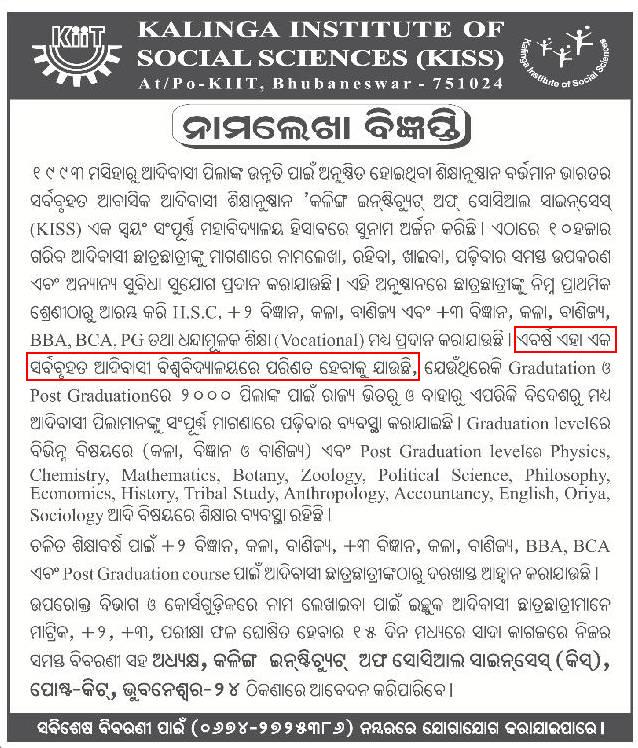
Considering the way KIIT is going one day the group may have the maximum number and variety of programs among all universities in India. Below are a list of programs at the Bachelors/Masters level that come to mind that the KIIT group does not yet have. Readers are requested to suggest additional programs.
- School of Architecture
- School of Physical and Earth Sciences (Mathematics, Statistics, Physics, Chemistry, Geology, Earth Science)
- School of Life Sciences (Biology)
- Schoolof Liberal Arts (Economics, Political science, Geography, Philosophy, Sociology, Anthropology, History, Linguistics, Psychology, Sociology, Women and Gender studies)
- School of Public Health
- School of Archaeology
- School of performance arts (Music, Dance, Theater, various instruments, various kinds of vocals) – with regular events for locals
- School of Fine Arts and Creative Writing (Art education, Art history, Art studies, ceramics, drawing, fibres, metals, painting, photography, print making)
- School of Business (Accountancy, Finance, Entrepreneurship, Marketing)
- Additional Engineering fields: Industrial engineering, Chemical engineering, Bioengineering, Petroleum Engineering, Mining Engineering, Metallurgical Engineering, Biomedical Engineering, Environmental Engineering, Aerospace Engineering
- Culinary Institute
- School of Public Policy and Government
- School of Energy and Sustainability
- School of Construction
- School of Medical technology (including Bio-Medical Informatics)
- School of Nursing
- Programs in Social Service
- School of Agriculture
- School of Veterinary Science
- School of Education (including special education)
- School of Agri-business, Food science and Nutrition
- School of Tourism
- School of Sports sciences and Kinesiology
- School of Religious studies
- School of Aviation and Aviation management
June 7th, 2009
KIIT School of Biotechnology has faculty that are involved in research. Following is its current faculty list that I obtained from http://www.kiitbiotech.ac.in/faculty.htm. All faculty with the rank of Senior Lecturer and above have Ph.Ds and many are with multi-year post-doctoral experience abroad. I think this school may soon challenge the Institute of Life Sciences, Bhubaneswar in term of research.
| Permanent Faculty |
| |
Dr.Mrutyunjay Suar, Director (msuar@kiitbiotech.ac.in) |
| |
Dr.Chanakya Nath Kundu, Assistant Professor (cnkundu@kiitbiotech.ac.in) |
| |
Dr.Avinash Sonawane, Assistant Professor (asonawane@kiitbiotech.ac.in) |
| |
Dr.Vishakha Raina, Assistant Professor (vraina@kiitbiotech.ac.in) |
| |
Dr.Snehasish Mishra, Assistant Professor (smishra@kiitbiotech.ac.in) |
| |
Dr.Sasmita Mohanty, Assistant Professor (smohanty@kiitbiotech.ac.in) |
| |
Dr.Raja Mansingh Rathore, Senior Lecturer (rmrathore@kiitbiotech.ac.in) |
| |
Dr.Biplab Sarkar, Senior lecturer ( bsarkar@kiitbiotech.ac.in) |
| |
Mr.J.S. Purohit, Lecturer (jspurohit@kiitbiotech.ac.in) |
| |
Mr.Gopal Chowdhary, Lecturer (gkchowdhary@kiitbiotech.ac.in) |
| |
Mr.Prabhat Kumar Rout, Lecture (pkrout@kiitbiotech.ac.in) |
Would not it be wonderful if KIIT builds up similarly in Mathematics, Physics and Chemistry and challenges NISER?
December 21st, 2008
- Ajay Binay Institute of Technology Cuttack (ABT) Pvt.
- Apex Institute of Technology & Management, Pahal Bhubaneshwar (APT) Pvt.
- Bhubaneswar Engineering College Khurda (BEC) Pvt.
- BRM International Institute of Technology Bhubaneswar (BII) Pvt.
- C. V. Raman College of Engineering Bhubaneswar (CVR) Pvt.
- Central Institute of Plastics Engineering And Technology Bhubaneswar (CPT) Govt.
- Centurian Institute of Technology Khurda (CIK) Pvt.
- College of Engineering & Technology Bhubaneswar (CET) Govt.
- College of Engineering Bhubaneswar Bhubaneshwar (CEB) Pvt.
- Dhaneswar Rath Institute of Engineering and Management Studies Tangi, Cuttack (DRM) Pvt.
- Eastern Academy of Science & Technology Phulnakhara, Khurda (EAS) Pvt.
- Gandhi Engineering College Bhubaneswar (GEC) Pvt.
- Gandhi Institute for Technology Bhubaneswar (GIF) Pvt.
- Gandhi Institute of Technological Advancement Badaraghunathpur, Bhubaneswar (GIB) Pvt.
- Gandhi Institute of Technology & Management Khurda (GIK) Pvt.
- Ghanashyama Hemalata Institute of Technology & Management Chhaitana Puri (GHT) Pvt.
- Gurukul Institute of Technology,Janla Bhubaneswar (GKT) Pvt.
- Hi-Tech Institute of Technology Khurda (HIT) Pvt.
- Indic Institute of Design & Research Khurda (IID) Pvt.
- Indus College of Engg. Bhubaneswar (IDU) Pvt.
- Jagannath Institute of Engineering & Technology Cuttack (JIC) Pvt.
- Konark Institute of Science & Technology Jatni,Bhubaneswar (KIS) Pvt.
- Koustav Institute of Technology Bhubaneswar (KIT) Pvt.
- Koustuva Institute of Self Domain (for Women) Bhubaneswar (KID) Pvt.
- Krupajala Engineering College Pubasasan, Bhubaneswar (KEC) Pvt.
- Maharaja Institute of Technology,Bhubaneswar Bhubaneswar (MIK) Pvt.
- Mahavir Institute of Engineering and Technology Paniora, Bhubaneswar (MIB) Pvt.
- Modern Institute of Technology & Management Khurda (MIM) Pvt.
- Nalanda Institute of Technology Bhubaneswar (NIT) Pvt.
- NM Institute of Engineering & Technology Sijua, Bhubaneswar (NMI) Pvt.
- Orissa Engineering College Nijigarhkurki, Bhubaneswar (OEC) Pvt.
- Rajdhani Engineering College Bhubaneswar (REC) Pvt.
- Silicon Institute of Technology Bhubaneswar (SIT) Pvt.
- Subas Institute of Technology Gyana Vihar, Barang, Bhubaneswar 754 005 Orissa
- Synergy Institute of Engineering and Technology Dhenkanal (SYN) Pvt.
- TempleCity Institute of Technology & Engineering Khurda (TCT) Pvt.
- The Techno School Bhubaneswar (TTS) Pvt.
- Trident Academy of Technology Bhubaneswar (TAT) Pvt.
- Agricultural Engineering at OUAT, Bhubaneswar
- KIIT Bhubaneswar
- ITER Bhubaneswar
- IIIT Bhubaneswar
- IIT Bhubaneswar
Following are some that are in the pipeline and most likely to start in 2009.
- School of Engineering at the proposed World Class Central University
- HI – Tech College of Engineering, Rasulgarh, Pandara, Bhubaneswar, Orissa
- International Institute of Engineering & Technology (IIET) 290 Bhatkhuri, Gangapada, Bhubaneswar 752 054 Orissa
- SRM College of Engineering At Giringaput, P.O. Mendhasala, Orissa
- PJ College of Management & Technology At Kesora, P.O. Bankual, Bhubaneswar 751 002 Orissa
- KMBB College of Engineering & Technology At Mahatpalla, Tahasil Khurda Orissa
- Pan Institute of Technology, Knowledge City Unit – 7, Bhubaneswar 751 003 Orissa
- Vivekananda Institute of Technology At Chhatabar, P.O. Dandi, Chhatabar P.S. Chandaka, Bhubaneswar Orissa
- Bhubaneswar Institute of Technology (BIT) At Harapur, P. O. Janla District : Khurda, Pin 752 054 Orissa
- Pioneer Institute of Technology Village : Ambilijhari Mouza : Machhapangi, PS Choudwar, District : Cuttack Orissa
- MITS College of Engineering Mouza: Alkar At P.O. Janla, Bhubaneswar 751016 Orissa
August 3rd, 2008
Following is an excerpt from a report in Pioneer.
… the Synovate survey of the Outlook magazine has put KIIT School of Technology, a constituent of KIIT University in the 18 the position among the top 100 private technical colleges of the country in the same league as prestigious institutes such as BITS of Pilani, PSG College of Technology of Coimbator, BIT of Mesra, Thapar University of Patiala and VIT University of Vellore. It is the only institute from Orissa to feature in this elite list of private engineering colleges.
The survey, which conducted every year to reveal the names of 100 topmost colleges of the country, focuses on five basic parameters such as intellectual capital, pedagogic system, industry interface, infrastructure and facilities and placements. However, while most of the colleges figuring in the list have a history of 50 to 100 years, KIIT is only ten- years-old. KIIT has substantially improved its rank this year compared to the previous years. It was ranked 37th in 2007 and 100th in the year before.
June 21st, 2008
Business Standard has a nice article on Kalinga School of Rural Management. Following are some excerpts.
Unlike IRMA, which offers a two-year Post Graduate diploma in Rural Management, KSRM will be able to award an MBA in Rural Management to the first batch of 72 students passing out in 2009 owing to its deemed university status.
The institute has also received the All India Council for Technical Education (AICTE) approval for increasing the number of students from 74 to 100-120 for the second batch of students in 2008.
LK Vaswani, who taught at IRMA for 16 years and is now the director of KSRM, says the new institute retains the IRMA model of building and sustaining a partnership between rural people and committed professional managers.
But according to Vaswani, a key element that separates IRMA from KRSM, is the lack of inhibition towards its students choosing to work with the private sector.
…
“KSRM has decided to avoid taking a sectoral association. We do not believe in having any inhibitions towards the corporate sector considering more and more of them are entering the development sector. In fact, we are associated with the private sector where our students can have hands-on experience in agri-business, Corporate Social Responsibility (CSR), NGO management, finance and the like,†says Vaswani.
He added that in terms of on-the-field education or experiential learning, the institute hopes to surpass all other rural management schools.
For starters, the institute will hold live field training modules for a duration of 12 weeks which will be conducted thrice a year. The first batch of 72 students from 16 states will be asked to go back to their own states and adopt a village where they will work at the grassroot level. Students will also work with KIIT’s tribal school which has 3,000 children studying in its campus.
While IRMA, the Indian Institutes of Management (IIMs) and other top B-schools face a shortage of faculty, KSRM officials say it does not worry them.
Along with seven core rural management faculty members, three of whom are from IRMA, Vaswani says faculty from the KIIT university’s other institutes like school of law, school of management, school of technology, school of social sciences etc. contribute to almost 50 per cent of the teaching load, making it a very healthy student-faculty ratio. Around 15 rural management faculty will be inducted in 2008.
…
The institute has proposed an academic collaboration with the Department of Science and Technology (DST) to ensure the participation of its students in the government’s ‘Science for Society’ programme in partnership with over 40 NGOs.
December 26th, 2007
Following is an excerpt from a Statesman report.
Under the partnership programme, short-term postgraduate courses spanning six months to one year in Technology Infrastructure Service (TIS) will also be offered.
These courses will cater to the growing demand of skilled manpower in the IT infrastructure management service (IMS).
It is becoming a real challenge for all the IT companies in India to get manpower with the right skill for IMS.
These courses will be conducted as per as the customised course curriculum prepared by Wipro.
Trainers will be arranged by Wipro to train the teachers of KIIT for successfully conducting these courses with the aim to prepare the IT industry ready for IMS practice.
The KIIT University has also signed another MoU with Wipro, under which diploma students of KIIT will be trained in the English language communication skills with a customised course curriculum to make them industry ready in IMS practice.
Apart from this initiative, Wipro will also conduct a recruitment drive for the diploma students of the university every year
September 6th, 2007
Following are excerpts from a report in The Hindu:
… Surmounting heavy odds, the well-trained rugby team of the Bhubaneswar-based Kalinga Institute of Social Sciences (KISS) was now ready to take on the world, representing India at an under-14 international school rugby tournament in London.
For the products of the country’s largest school for tribal communities, rugby was just the right tool to unleash their collective talent. Hitherto dismissed to their miserable tribal hinterland, the students had a mission: to prove their mettle to a world cynically ignorant of the tribal life, their dreams and ambitions.
KISS, a sister concern of the KIIT Deemed University, had picked them out of their poverty-stricken families to offer an education, to get them a slice of mainstream life. Nurtured in the residential campus since age six, the team members were now prepared to announce their arrival. London beckoned, so did recognition and fame.
The training
Behind their collective exuberance was a well-tuned method. Thirty students had been selected from a first list of 56, who underwent rigorous training by a World Rugby Association coach.
The 30 proved their worth at a tournament in Kolkata on July 16, watched closely by their sponsors, the Kolkata Jungle Crows.
The final 12 now await the flight for the big fight on September 24, but not before some fine-tuning by an English coach, Paul Walsh, and two coaches from the Kolkata Rugby Association.
“We are confident of beating the other teams.” This remark by the KISS Rugby team captain to a visiting media team from Bangalore, had a solidity built on months of disciplined training. “From 6 a.m. to 7.30 a.m., 4 p.m. to 6.30 p.m., we are at it every day,” explained the team’s school coach, Manash Jena.
The team
Tag Rugby was the team’s first brush with the game, 18 months ago. Graduating to full rugby in quick time, the team captained by Bikash Chandra Murmu practised hard. Any tribe-based differences forgotten, the students were now part of one team. It had Chitta Ranjan Mumu and Babula Malka, Raj Kishore Murmu and Bukai Hansda, Niranjan Biswal, Hadi Dhangada Majhi, Sahadev Majhi, Gauranga Jamuda, Narsingh Kerai, Barial Beshra and Ganesh Hembram. Represented were the tribes Banda, Santal, Bathudi, Kandha and Kolha, whose people were otherwise dismissed to the poor rural backyard of Orissa.
The vision
Tribal people make up 23.13 per cent of Orissa’s population. It needed a body as systematic as KISS to pull them out of obscurity and neglect.
It was eventually left to philanthropist and Kalinga Institute of Industrial Technology (KIIT) founder Achyutananda Samanta to make that critical difference through KISS. …
August 15th, 2007
KISS, Kalinga Institute of Social Sciences is made and run by the promoters of KIIT University. Hindu has a very nice article about it. Following are some excerpts.
A sister concern of the Kalinga Institute of Industrial Technology (KIIT), KISS is a working dream that trained the tribal children to be self-reliant, resourceful and empowered to tackle the challenges of life.
For the visiting media team from Bangalore, KISS was an education in looking beyond urban-centric development. From the well-stocked library, hostel and computer centre to a medical facility that insured every child, KISS is also a home away from home. The institute ensures that the children have enough exposure to their tribal culture, heritage and tradition. …
Today, there are children here from most of the 52 tribes of Orissa, including 13 primitive tribes. This year, we added 700 more tribal children to reach the strength of 5,000,” he informed.
…
For 22 of the brightest from KISS students, Dr. Samanta had reserved free engineering seats in KIIT, five per cent of the total intake.
“This year, the BCA and BBM courses were opened for them. The tribal students will leave this organisation with a job.” As the KIIT Deemed University Chancellor assured this, he was working on an expansion plan: a project to add another 5,000 children to India’s biggest residential tribal school in the next three years.
August 8th, 2007
